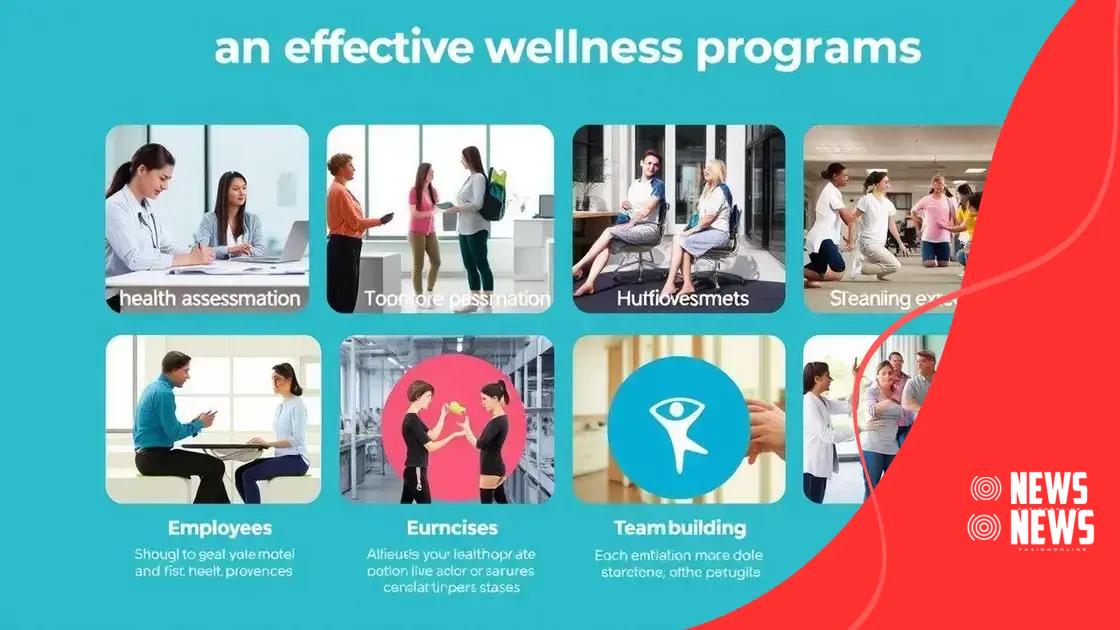Employee wellness programs: investing in health

Employee wellness programs are structured initiatives designed to enhance the health and well-being of workers, leading to increased productivity, lower healthcare costs, and improved employee satisfaction.
Employee wellness programs are gaining attention as businesses recognize their importance in creating healthier, happier work environments. Have you ever thought about how these programs can enhance team spirit and productivity? Let’s dive into their benefits and implementation strategies.
Understanding employee wellness programs
Understanding employee wellness programs is essential for modern businesses looking to create a positive workplace environment. These initiatives promote overall well-being and encourage healthier lifestyle choices among employees.
When companies invest in wellness programs, they not only benefit employees but also improve productivity and morale. A well-structured wellness program can lead to reduced absenteeism and lower healthcare costs, making it a smart investment in the workforce.
Key Features of Employee Wellness Programs
There are several important elements that contribute to effective employee wellness programs. Here are a few you should consider:
- Health Risk Assessments: Regular assessments help identify potential health issues among employees.
- Fitness Initiatives: Offer fitness challenges, gym memberships, or group activity sessions to promote physical activity.
- Mental Health Support: Access to counseling services and mental health resources is crucial for overall wellness.
- Flexible Work Options: Providing options for remote work can greatly reduce stress and improve work-life balance.
Furthermore, a successful program will involve employees in the planning process to ensure it meets their needs and interests. By doing so, you’re more likely to achieve higher participation rates and create a program that resonates with your team.
Advantages of Wellness Programs
Investing in employee wellness programs comes with numerous advantages for both employees and employers.
- Enhanced Employee Engagement: Engaged employees are more productive and committed to their roles.
- Improved Culture: A focus on wellness fosters a supportive and collaborative workplace culture.
- Attraction and Retention: Competitive wellness benefits can draw top talent and keep valuable employees.
- Lower Health Costs: Healthier employees lead to reduced health insurance claims and costs for the company.
Ultimately, understanding employee wellness programs means recognizing their potential to transform the workplace. By focusing on holistic employee health, businesses can thrive, creating an environment where everyone can succeed.
Benefits of investing in workplace health
Investing in workplace health reaps many benefits that positively affect employees and employers alike. Companies that prioritize health see improved morale and overall productivity, as well as a happier work environment.
Healthier employees tend to have higher energy levels and are more engaged in their work. This leads to lower absenteeism rates, which can significantly reduce the costs associated with employee turnover. By fostering a culture of health, businesses can also enhance their reputation as desirable places to work.
Key Benefits of Investing in Workplace Health
There are many advantages to implementing health initiatives in the workplace:
- Reduced Healthcare Costs: Healthy employees generally have lower medical expenses, which can greatly benefit company budgets.
- Increased Productivity: Well employees are more focused and efficient, leading to better outputs and success.
- Better Employee Retention: When employees feel valued and cared for, they are less likely to leave for other job opportunities.
- Enhanced Work Culture: A strong health focus can create a supportive and collaborative atmosphere that boosts team spirit.
Moreover, fostering workplace health encourages employees to make healthier life choices, which can lead to long-term benefits both personally and professionally. Programs can range from physical fitness to mental wellness, addressing various aspects of health.
Long-Term Impacts
In the long run, investing in workplace health sets the foundation for a successful organization. Employees who feel supported tend to engage more with their roles, contributing to better project outcomes. Creating a sustainable wellness program can help stabilize workforce dynamics and prepare the organization for future challenges.
As a result, investing in employee health is not just a trend; it is a strategic move towards achieving lasting success for any organization.
Key components of effective wellness programs

An effective wellness program focuses on several key components that cater to the diverse needs of employees. Understanding these components can help organizations build robust initiatives that truly make a difference.
To start, leadership support is vital. When company leaders prioritize wellness, it sets the tone for the entire organization. This support can manifest in various forms, such as budget allocations or promoting health events.
Core Elements of Successful Wellness Programs
Here are some crucial elements that should be considered when designing wellness programs:
- Comprehensive Health Assessments: Regular assessments help identify the health needs of employees and tailor programs accordingly.
- Diverse Offerings: A variety of activities, such as fitness challenges, mindfulness workshops, and nutritional education, can cater to different interests.
- Accessibility: Programs should be easy to access so all employees can participate, whether onsite or remotely.
- Social Support: Encouraging teamwork through group activities promotes a sense of community among employees.
Moreover, tracking the participation and satisfaction levels of employees is essential for program effectiveness. Feedback allows organizations to adapt their strategies and make improvements where needed.
Creating a Sustainable Wellness Culture
For a wellness program to thrive, it must become part of the organization’s culture. This requires ongoing communication and engagement. Companies should continuously promote health benefits and remind employees to take part in wellness activities. By fostering an environment focused on well-being, organizations not only improve employee health but also encourage a higher quality of work life.
Integrating these components into a wellness program paves the way for a healthier workforce. Ultimately, a strong focus on wellness contributes to the success of both employees and the organization itself.
Strategies to implement wellness initiatives
Implementing wellness initiatives can greatly enhance employee satisfaction and health. To achieve this, organizations must adopt effective strategies that cater to the needs of their workforce. By taking the right steps, companies can create a lasting impact on employee well-being.
A solid plan starts with assessing the specific needs of employees. Surveys and feedback sessions allow companies to understand what wellness programs will resonate best. This engagement ensures individuals feel valued and heard, increasing participation levels.
Key Strategies for Successful Implementation
Here are some essential strategies to consider when rolling out wellness initiatives:
- Build Leadership Support: Get managers and executives involved in promoting programs. Their enthusiasm can motivate employees to participate.
- Create Clear Communication: Inform employees about available programs and the benefits they offer. Use various channels to reach everyone effectively.
- Incorporate Flexibility: Offer wellness options that accommodate different schedules and preferences, such as remote wellness sessions or on-site activities.
- Encourage Team Participation: Promote teamwork through group challenges. This fosters a sense of community while making wellness fun.
Additionally, ongoing evaluation of program effectiveness is crucial. Organizations should establish metrics to track participation rates and measure health outcomes. Feedback mechanisms help identify areas for improvement and reinforce a commitment to employee wellness.
Engaging Employees in Wellness
Engagement is at the heart of successful wellness initiatives. Implementing gamification elements, such as challenges and rewards, can make participation more enticing. Organize events that highlight healthy living and encourage friendly competition among teams. This can boost morale and promote a culture of wellness.
Overall, by actively involving employees and offering diverse, flexible options, companies can successfully implement wellness initiatives that truly enhance health and productivity in the workplace.
Measuring the success of wellness programs
Measuring the success of wellness programs is vital to ensure they provide value and meet employee needs. Organizations can track the effectiveness of their initiatives by using various methods to gather data and feedback.
Firstly, setting clear goals and objectives is crucial. These benchmarks help in assessing the impact of the programs over time. For instance, a company might aim to reduce health care costs or improve employee attendance as measurable outcomes.
Key Metrics to Consider
To evaluate success, organizations should consider the following metrics:
- Participation Rates: The percentage of employees engaged in the wellness program can indicate its popularity and relevance.
- Health Outcomes: Monitoring improvements in employee health, such as reductions in blood pressure or cholesterol levels, can demonstrate the program’s effectiveness.
- Employee Satisfaction: Conducting surveys to gauge employee satisfaction with the wellness initiatives helps understand their perceptions and areas for improvement.
- Cost Savings: Analyzing changes in health care costs and absenteeism rates can reveal significant financial benefits of wellness programs.
Furthermore, it’s essential to gather feedback continuously. Regular evaluations allow companies to adapt their initiatives based on employee needs and preferences. This proactive approach leads to more personalized and targeted wellness offerings.
Utilizing Technology for Evaluation
Incorporating technology can streamline the measurement process. Wellness platforms often provide valuable insights and analytics that track engagement and progress. Wearable devices can also contribute by monitoring health metrics in real-time.
Overall, measuring the success of wellness programs requires a comprehensive approach. By focusing on key metrics, and regularly adapting strategies based on feedback, organizations can create effective programs that genuinely improve employee well-being.
employee wellness programs leads to a healthier, happier workforce. By focusing on key components like leadership support, diverse offerings, and ongoing evaluation, organizations can create an environment where employees thrive. Remember to measure success through participation rates and health outcomes. Embracing these strategies not only benefits employees but also enhances company productivity and morale. With the right approach, wellness initiatives can become a vital part of your workplace culture.
FAQ – Frequently Asked Questions about Employee Wellness Programs
What are employee wellness programs?
Employee wellness programs are initiatives aimed at promoting health and well-being among employees. They include activities like fitness classes, mental health support, and health screenings.
How can I measure the success of a wellness program?
Success can be measured using metrics such as participation rates, health outcomes, employee satisfaction surveys, and cost savings related to healthcare.
What benefits do wellness programs provide to companies?
Wellness programs can lead to lower healthcare costs, improved employee morale, increased productivity, and reduced absenteeism.
How can I engage employees in wellness initiatives?
Engage employees by promoting team challenges, providing diverse wellness options, and encouraging leadership support. Regular feedback and incentives also help boost participation.





